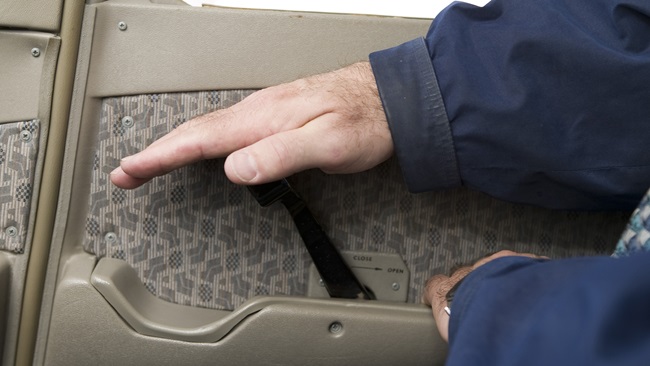Who's really in charge
The authority and responsibility of the captain should never be in doubt.

Flights probably appear that way to passengers, air traffic controllers, and those outside the cockpit. In most mishap flights, however, the uneventfulness is a façade, like paint over corrosion. All looks fine from a distance, until the corrosion penetrates the surface and reveals decay so deep that structural failure is underway.
To the four passengers in the back of a Bombardier Challenger 605 jet headed from Coeur d’Alene, Idaho, to Truckee-Tahoe Airport near Lake Tahoe, the flight seemed to be progressing uneventfully, but forward of the plush interior, operations on the flight deck were corroding. Two pilots, unfamiliar with each other and with the Part 91 operation they were contracted to fly for, were struggling with crew resource management, and more specifically, with each other. The 43-year-old captain with a couple hundred hours in Challenger 600s was in command and the flying pilot on the mishap leg. His 56-year-old first officer had twice the captain’s total hours and 20 times more Challenger 600 hours. Generational friction, a widely recognized source of workplace disharmony in parts of our society, seeped into the Bombardier cockpit. A younger, less experienced pilot was in charge of an older, assertive pilot, who had likely mentored many pilots the same age as the captain he was now taking direction from. When interpersonal friction occurs in the office, at zero knots and 1 G, it’s annoying, emotionally exhausting, and degrades productivity. When it occurs at 150 knots on one of the most demanding maneuvers in aviation, it can turn deadly.
Trouble mounted in the descent to Truckee. The crew asked for the RNAV to Runway 11, but were cleared for the RNAV to Runway 20. Both pilots agreed Runway 20 was too tight for their computed 4,600-foot landing distance, driven by a 9,000-foot density altitude in the hot July afternoon. The captain decided, and the first officer agreed, to keep the RNAV Runway 20 approach, then circle to land on the longer Runway, 11. A fatal decision. They didn’t press the controller for the approach they preferred. Why did the captain decide to accept the Runway 20 approach and circle to Runway 11, rather than pressing for the RNAV to 11? Maybe he didn’t want to reconfigure the flight management system, deleting one approach and adding another. Maybe he didn’t want to deviate 15 miles west to the initial approach fix for Runway 11. Maybe he wanted to cooperate with ATC and help their flow. After all, it’s a simple circle. Once visual with Runway 20—which should happen early based on a forecast of 2,300-foot broken ceiling and 4 to 5 miles visibility—just start a right turn for 90 degrees to intercept a standard left downwind for a VFR pattern to Runway 11.
The first officer picked up the AWOS at Truckee, but in relaying the weather information to the pilot, he didn’t mention that smoke had lowered visibility. Why? Maybe he got distracted during his weather brief to the captain. Maybe he didn’t think the reduced visibility—which should still be 3 miles at worst—was relevant enough to mention. If that’s what he thought, it was a misjudgment that added to the accident chain of events. Would the change in visibility have impacted the captain’s decision to circle; would an early heads up have prepared the captain for a difficult visual pick up? Visibility—specifically the captain’s visual troubles picking up and keeping sight of Runway 11 in the smoke—proved a fatal limitation.
The crew didn’t brief the new approach (a violation of their operational procedures) and struggled throughout the remainder of the flight for precision and stability, and to just get ahead of the aircraft. ATC instructed the crew to hold, but the captain (the pilot flying) was slow to comply so the first officer (the pilot monitoring) started the turn into holding, an egregious breach of crew protocol for aircraft control that the first officer would later repeat. It would prove to be another link in the accident chain. The pilot monitoring handles radios and helps with programming and confirming the FMS, but does not initiate a change in aircraft control without direction, or approval from the pilot flying, in this case, the captain.
ATC cleared the crew for the RNAV Runway 20 approach. A few seconds later, at the start of the approach, the first officer commented they were too fast and suggested a 360-degree turn. A maneuver and a mindset learned through experience. The captain rejected the request, missing a valuable opportunity to gain time and space to work back ahead of the aircraft. Maybe they were behind schedule. Maybe the younger captain didn’t want to admit to the older first officer that he was struggling, perhaps he wanted to prove to the older FO, and maybe to himself, that he could keep pace. A crucial mistake. He would continue fast throughout the approach and circle. Excessive speed would be another link in the mishap chain.
Biting exchanges in the moment and delayed response to actions requested, and needed, added to crew friction and ultimately degraded performance on the approach.
Inbound from the initial approach fix, the captain called for flaps 20 while too fast, and the first officer reproved him by quoting the standard callout and correct speed. After a few seconds, and now slower, the captain again asked for flaps 20, and the first officer responded they’d already been selected, but in fact they had not been. Four seconds later, flaps were selected to 20. Crew agitation was growing and coordination was unravelling as they neared the critical section of the approach.
The captain asked the first officer to deploy the landing gear, but the first officer delayed, and again responded with a reproach, quoting the standard callout and suggesting the before-landing checklist. The captain again asked for the landing gear. The captain asked for flaps 30 and the first officer rebuked him, “No, we’re at flaps thirty, gear down.” The captain immediately pushed back, “flaps thirty.” Barreling inbound inside the final approach fix, behind on configuration, on a circling approach, without the airfield insight, the crew is sniping over standard callouts and terminology. A breach in professionalism. The post-flight debrief is a more appropriate time to review errors and discuss corrections. Biting exchanges in the moment and delayed response to actions requested, and needed, added to crew friction and ultimately degraded performance on the approach.
A few seconds later the first officer reported the airport in sight and called for the captain to make a 90-degree right turn. The captain, now apparently off autopilot and hand flying, could not pick up the airport despite repeated attempts by the first officer to point it out. The first officer called for the captain to roll out, some 30 degrees shy of a 90-degree turn, a critical call. The early rollout placed the aircraft on an angled downwind toward the runway, thus squeezing the base. Why did the first officer call for the early rollout? Perhaps he misjudged the aircraft’s vector. Perhaps he was worried about slightly rising terrain, or losing visual of the airport in the smoke. Whatever the reason, his vector compressed their turning room, and they were still fast. The challenges of fast visual maneuvering while configured in a tight, low pattern with limited visibility are exactly why circling approaches are so challenging. Many professional operations don’t allow them. The NTSB has an advisory circular warning against the hazards of circling approaches. They should not be attempted without a full briefing of speeds, turn points, configuration changes, and crew responsibilities. None of which this crew briefed before starting the approach.
Fast, on an angling downwind, the first officer stated, “I’m going to get your speed under control for you,” and the aircraft slowed. Another overstep by the first officer to manipulate the aircraft without direction or consent from the pilot flying. Fast, and tight to the runway on an angling base leg, the first officer made his first of several requests to take control of the airplane. The captain did not respond. Less than a mile from the runway threshold, still fast, almost twice as high as they would be on a stabilized approach, the aircraft flew through the extended centerline. The spoilers—panels on top of the wing that can be extended to reduce speed and increase drag—were then fully deployed by the manual lever between the pilots. It’s not clear who deployed them. It’s the kind of action that should not be taken without direction from the pilot flying. The spoilers reduced the Challenger’s maneuvering capability and lowered the stall margin. The aircraft banked left as the crew kept turning back to the extended centerline and power was reduced to 28 percent. Power back, spoilers fully deployed, close to 40 degrees of bank, the stick shaker activated. The captain asked, “What are you doing?” The stall warning activated and the stick pusher fired. The stick pusher moves aggressively to push the yoke forward and reduce angle of attack when a stall is imminent. The captain again asked, “What are you doing?” The first officer responded: “Let me have the airplane! Let me have the airplane! Let me have the airplane!” The stick pusher and shaker disengaged for about two seconds, indicating the pusher did its job, but the crew didn’t continue the recovery action. The shaker re-engaged, then the pusher, followed by an uncontrollable left wing drop and roll, classic Bombardier stall characteristics. At lower than 400 feet agl, the crew had run out of speed and altitude and had no further chance of recovery. All aboard perished.
Even in our collaborative era of engaged and respectful crew resource management, the authority and responsibility of the captain can never be in doubt. Nor can there be any ambiguity in who is flying the airplane. Both were muddled on this fatal approach. It’s unclear who was in control of the aircraft in the final seconds before the aircraft departed controlled flight. The captain’s errors in callouts and configurations clearly annoyed the more experienced first officer. The first officer’s assertiveness bothered the captain and seemed disrespectful. Both of them had a different plan for maneuvering the aircraft in the final stages of the approach and overshoot, and they were fighting against each other, surprising each other. Neither of them took control of the decaying situation and called for the single, simple action that any crew member has a responsibility to call on a destabilized approach. A call that would have penetrated their disharmony and salvaged an increasingly harrowing situation: “Go around.”



